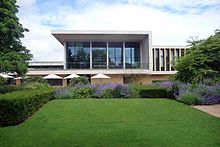The Sainsbury Laboratory Cambridge University (or SLCU)[1] is an independently funded British research institute based at the Cambridge University Botanic Garden. Its aim is to elucidate the regulatory systems underlying plant growth and plant development.
 Exterior of the Sainsbury Laboratory from the Cambridge University Botanic Garden | |
Academic affiliation | University of Cambridge |
|---|---|
| Endowment | Gatsby Charitable Foundation |
| Director | Henrik Jönsson |
| Location | , |
| Architect | Stanton Williams |
| Website | www |
Senior research staff
editAs of 2022, senior research staff include:
- Professor Henrik Jönsson, Director since 2020[2]
- Dr James Locke, Associate Director and Royal Society University Research Fellow
- Professor Ottoline Leyser, Research Group Leader,[3] Director from 2013 to 2020[2]
- Professor Yrjö Helariutta, Research Group Leader
- Professor Elliot Meyerowitz, Inaugural Director and Distinguished Associate
- Professor Giles Oldroyd, Research Group Leader
- Dr Alexander Jones, Research Group Leader
- Dr Edwige Moyroud, Research Group Leader
- Dr François Nédélec, Research Group Leader
- Dr Sebastian Schornack, Research Group Leader and Royal Society University Research Fellow
- Dr Chris Whitewoods, Career Development Fellow
- Dr Sarah Robinson, Career Development Fellow
- Dr Renske Vroomans, Career Development Fellow
History
editThe Sainsbury Laboratory houses 120 plant scientists studying plant development and diversity in state-of-the-art laboratory facilities. The building was made possible by the award of an £82 million grant[citation needed] from the Gatsby Charitable Foundation, one of the Sainsbury family charitable trusts.[4] The work of the laboratory complements that of the Sainsbury Laboratory at Norwich.[5]
Construction of the 11,000-square metre building,[4] led by Kier Group, began in the private working and research area of the Botanic Garden in February 2008 and was completed in December 2010. The building was opened on 27 April 2011 by Elizabeth II.[6]
The laboratory building also provides plant growth facilities and a home for the University Herbarium, which contains over one million pressed and dried plant specimens from around the world, including the great majority of those collected by Charles Darwin on the Beagle Voyage, and scientific research material relating to newly discovered plants from the 18th and 19th centuries.[citation needed]
Building
editThe Laboratory meets Cambridge City Council’s planning requirement for 10% renewable on-site energy generation through use of photovoltaic panels,[7] and has been awarded a BREEAM 'Excellent' rating. The Gilmour Suite, in a wing of the Sainsbury Laboratory, provides a public café and terrace for Botanic Garden visitors and is open all year during the garden's public opening hours. The building was awarded the Stirling Prize for architecture in 2012.[8]
| Architect: | Stanton Williams |
| Furniture consultant: | Luke Hughes[9] |
| Construction Start date: | February 2008 |
| Completion Date: | December 2010 |
| Date of Occupation: | January 2011 |
| Number of Occupants: | 150 |
| Gross Internal Area: | 11,000 m2 (120,000 sq ft) |
-
Stairs
-
Auditorium
-
Cubicles
Artwork
editThe laboratory has several artworks, including:
| Artist Name | Work |
|---|---|
| Norman Ackroyd | Galapagos |
| Susanna Heron | Henslow’s Walk |
| William Pye | Starburst |
References
edit- ^ "Sainsbury Laboratory Cambridge University". Retrieved 1 May 2011.
- ^ a b "Ottoline Leyser". National Academy of Sciences. Retrieved 9 March 2024.
- ^ Sedwick, Caitlin (2014). "Ottoline Leyser: The beauty of plant genetics". The Journal of Cell Biology. 204 (3): 284–285. doi:10.1083/jcb.2043pi. ISSN 0021-9525. PMC 3912528. PMID 24493584.
- ^ a b "What we do". www.slcu.cam.ac.uk. 2013. Retrieved 9 March 2024.
- ^ Amsen, Eva (15 November 2011). "An interview with Ottoline Leyser". Development. 138 (22): 4815–17. doi:10.1242/dev.075333. PMID 22028022.
- ^ "Opening of Sainsbury Laboratory". www.globalfood.cam.ac.uk. 4 May 2011. Retrieved 9 March 2024.
- ^ "The Sainsbury Laboratory, University of Cambridge". ARUP.
- ^ "Stanton Williams' Sainsbury Laboratory wins the 2012 RIBA Stirling Prize!". ArchDaily. 13 October 2012. Retrieved 19 April 2021.
- ^ "Sainsbury Laboratory". www.stantonwilliams.com.